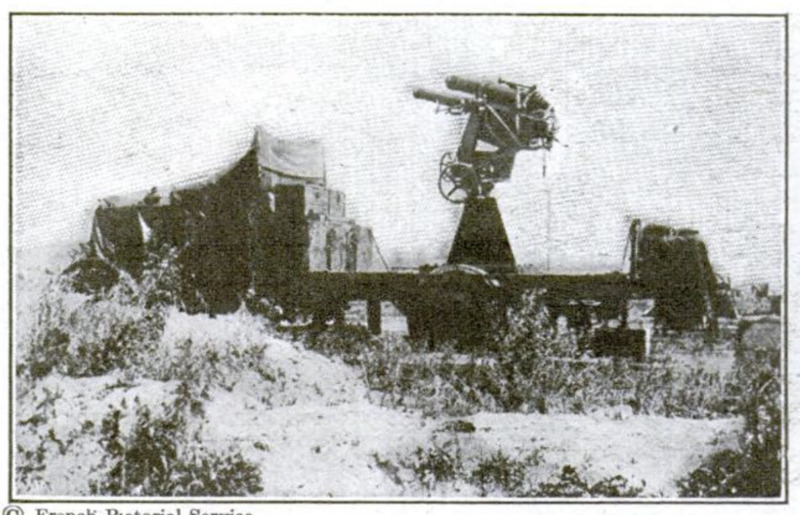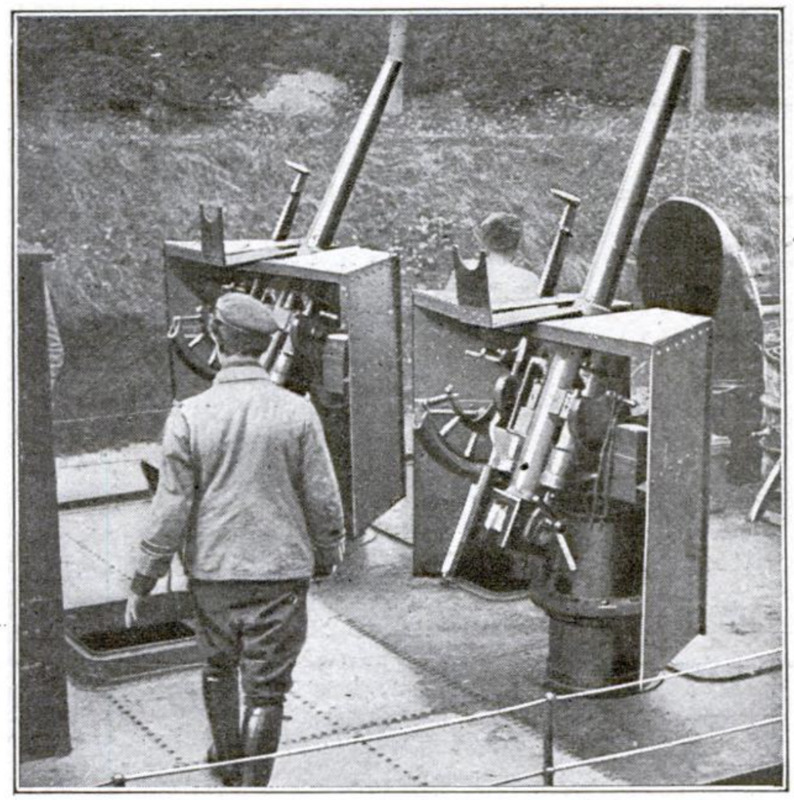-
Title (Dublin Core)
-
Anti-Aircraft Guns
-
Article Title and/or Image Caption (Dublin Core)
-
Gunning for Bird-Men. Some recent anti-aircraft guns with improvised mountings
-
Caption1: The Belgians mount fields guns on improvised revolvable platforms to be used as anti-aircraft guns
-
Caption 2: A British gun, mounted on an automobile truck, can be used horizontally as well as vertically
-
Caption 3: By a rather crude improvisation the deck guns on this small French torpedo boat in the Aisne Canal have benne adopted for use against aircraft
-
extracted text (Extract Text)
-
THE art of war has reverted to a
state similar to that which the in-
troduction of the use of gunpowder
and firearms
produced in
the fifteenth
century. Then,
conditions and
methods had
to be read-
justed to meet
the changes
produced by
a new and
powerful agent
of destruction,
not yet fully
understood;
now, new
means of war-
fare, evolved
by the marvelous resources of modern
science and engineering, have again unset-
tled conditions and caused an upheaval
upon a fearfully exaggerated scale.
Asinthefifteenth century,infantry
and artillery had to be armed with
makeshifts—hand grenades and pon-
derous bombards, improvised under
the very stress of battle. The chief
importance of infantry is once more
in its bodily impact; the role of
artillery is again to smash and over-
whelm everything by enormous pro- |
jectiles.
When it was found necessary to |
use the heaviest naval and siege
guns with the least possible delay,
mounts had to be improvised, which
bear a curious resemblance to by-
gone makeshifts. Even of the lighter
cannons, of smaller caliber, many
have undergone a‘ curious metamor- ¥
phosis which makes them resemble 3
the medieval “falconets” which oc-
casionally had to be pointed sky-
ward to reach the enemy's scouts
stationed on the watchtowers of
castles perched on lofty crags. These
modern guns also must be pointed toward
the sky to fire at the enemy’s scouts
seated in airplanes.
Several
standard
types of anti-
aircraft guns
were invented,
but so enor-
mous was the
increase in the
number and
activity of
‘military ~~ air-
planes and
other air-
craft, that the
supply of
standard anti-
aircraft guns
could not
keep pace with the demand. It became, |
imperative to improvise such guns by,
adapting field guns
of ordinary type to
the requirements of high-angle firing.
Some of these improvisations are shown
in the accompanying illustrations.
Field guns of regulation type were
mounted in different ways, but always
so that they could be aimed vertically as
well as horizontally or, changed from one
position to the other with the least pos-
possible diffi-
culty. In the |
case of the
Belgian gun
shown in one
of the pictures |
the complete |
field gun, with
its carriage,
tail and all the
rest has been
chained to a
column with a |
revolving
platform.
Only the |
barrel with |
its recoil |
tube has been
utilized to |
adapt the gun
for the auto- |
mobile truck.
But note the
ingenious fork |
in which the
gun is mount-
ed. It gives the gun a complete
horizontal firing circle, and, at the
same time enables it to be pointed verti-
cally with the greatest ease. This result
has been achieved by constructing the fork
so that it supports the barrel at a con-
siderable distance from the base column
upon which the fork is pivoted. Hence
it is possible to stand right beneath the
breech of the gun and to aim it as con-
veniently as one points a fowling piece.
Twin guns are shown on a French tor-
pedo boat, small enough to enter the
Aisne Canal. That the guns are, pri-
marily, intended to form part of the boat’s
armament against an enemy on shore or
on water is.apparent from the gun shields
which ‘give protection only against pro-
jectiles fired from approximately the
same level. By a few changes in the gun
shields and other details these guns have
been adapted for use against aircraft,
if the emergency should arise. That this
adaptation is purely an improvisation is
shown by the fact that the breech of the
guns, when they are pointing vertically
or nearly vertically, is so close to the deck
that it is extremely difficult to aim them.
In contrast to the fixed gun, which can
be used only against aircraft, the gun on
theautomobile
and the deck
guns on the
torpedo boat
can be used
at any angle
desired.
Launching
Seaplanes
from Ships
Wil
a big
seaplane is to
be launched
from the deck
of a ship (of
whatever type)
it is first
“tuned up” on
the launching
stage. Then
the ship is
swung dead
into the teeth:
of the wind
and put at full speed. To make sure of
the direction of the wind, for an error
would mean a “crooked” run and, per-
haps, the destruction of the seaplane, a
jet of steam is sent up in the exact center
of the extreme tip of the launching stage.
When the back-blown steam streams
straight along the middle plank of the
stage, the wind is “right.
At a signal by the captain the pilot
starts his engine full speed, while two
‘mechanics, braced against cleats on the
deck, hold back the tugging seaplane.
When the “tone” of the engine is right,
the wing commander brings down, his,
flag with a sharp jerk, falls on his face to.
avoid a collision, and the machine, freed
from the grip of the men holding it, jumps
away into space from the launching stage.
If everything was right, when the sea-,
plane started, its flight will be com-
paratively free from risk.
-
Contributor (Dublin Core)
-
Carl Dienstbach (writer)
-
French Pictorial Service (photo)
-
Kadel and Herburt (photo)
-
Language (Dublin Core)
-
eng
-
Date Issued (Dublin Core)
-
1918-08
-
pages (Bibliographic Ontology)
-
184-185
-
Rights (Dublin Core)
-
Public Domain (Google digitized)
-
References (Dublin Core)
-
Aisne
-
Archived by (Dublin Core)
-
Filippo Valle
-
Alberto Bordignon (Supervisor)
 Popular Science Monthly, v. 93, n. 2, 1918
Popular Science Monthly, v. 93, n. 2, 1918







